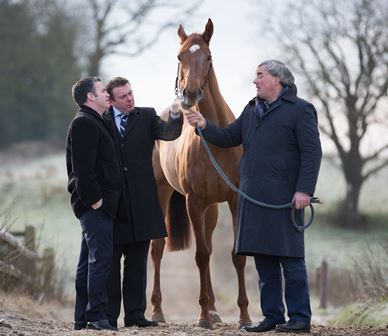Bone repair technology reconstructs Irish racehorse jaw
23 January 2015
An Irish racehorse successfully returned to racing after jaw reconstruction using a new bone repair material made from collagen and hydroxyapatite developed by the Advanced Materials and BioEngineering Research Centre (AMBER) at Trinity College Dublin.
The patented technology consists of collagen and hydroxyapatite, components native to bone, formed into a 3D porous ‘scaffold’ which acts as a bone graft substitute. Bone cells and blood vessels ‘cling’ to the scaffold, allowing for new tissue regeneration.
The bone repair material, called HydroxyColl, was developed by a team of AMBER researchers within the Tissue Engineering Research Group (TERG) in the Royal College of Surgeons in Ireland (RCSI) led by Professor Fergal O’Brien, Deputy Director of AMBER. It will be brought to market by RCSI spin-out company, SurgaColl Technologies. Regulatory approval for human use is forecast in the coming months and implantation in patients suffering from large bone defects planned this year.
Speaking at the event, Damien English TD, Minister for Skills, Research and Innovation said, “Material science underpins a wide range of market opportunities that have the greatest potential to deliver economic return through enterprise development and employment growth in Ireland. I congratulate Professor O’Brien, his team and collaborators at AMBER for this breakthrough solution that could have real application in the veterinary sector and which could ultimately improve the lives of thousands of people also.”
The first clinical use of the HydroxyColl was on a 2-year-old thoroughbred filly that had a large swelling in her jaw caused by a complex aneurysmal cyst. As a result of the cyst, the bone in the filly’s jaw was at risk of fracture and she was unable to chew adequately. The outcome is generally poor for aneurysmal cysts and euthanasia of the animal often necessary.

The horse, Annagh Haven, that had a jaw
repaired
and successfully returned to racing
The procedure was carried out by Dr. Florent David at University College Dublin’s Veterinary Hospital who removed the cyst and implanted sheets of the scaffold. The procedure has enabled repair of the bone tissue followed by restoration of normal bone shape and function. Since surgery, the horse (Annagh Haven) has returned to racing and has won or been placed in six of her races to date.
Prof. Stefano Sanvito, Acting Director of AMBER, said, “Our researchers are delivering world first discoveries; in fact we had four world first discoveries since launch which shows that Irish research is at the leading edge of material science worldwide. Today’s announcement on the new scaffold technology demonstrates our track record of pushing the boundaries of science to discover real solutions for people and we will continue to carry out excellent research that has clear societal impact.”